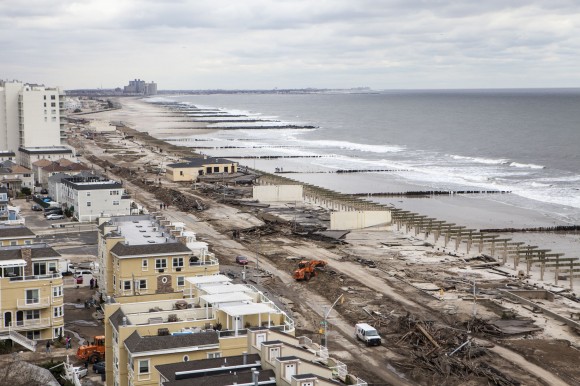When Hurricane Sandy roared through New Jersey two years ago, it not only tore up the shoreline. It also pushed out much of the middle class.
From Ocean City to Toms River, one-story cottages and bungalows damaged by the worst Atlantic storm on record are being replaced by multi-story homes that go for twice as much. Sales of million-dollar homes on the Jersey Shore surged to a seven-year high in the third quarter.
Sandy accelerated the turnover of existing homes to higher-priced ones, said Kevin Gillen, an economist at University of Pennsylvania’s Fels Institute of Government. Meanwhile, those relying on insurance claims and government grants are sometimes unable to rebuild as quickly as their wealthier neighbors.
“What we see right now along the water is that the people with resources, people who have a lot of money, right off the bat, they’re back in their houses enjoying it versus a lot of other people who are still struggling,” said Doug Quinn, who remains displaced from his Sandy-flooded home in Toms River, about 70 miles (113 kilometers) south of New York City.
Jersey Boardwalk
The outperformance of the rich on the Jersey Shore mirrors national trends since the recession ended in 2009, Gillen said. Between 2010 and 2013, median incomes fell for all Americans but the richest, a September Federal Reserve report showed.
“This overall economic recovery has been skewed to the upper half of the population,” Gillen said. “The more educated you are, the more accomplishments you have on your resume, the chances are you are better off today than you were a couple years ago in the depths of the recession.”
While multi-million dollar communities dot New Jersey’s Atlantic oceanfront, blue-collar workers have vacationed on its beaches and sailed along its inlets for generations. In the 1970s, New Jersey native Bruce Springsteen sang of wooing factory girls under the Asbury Park boardwalk.
Often, people inherited bungalows and other modest Shore homes dating to World War II, said Toms River Mayor Thomas Kelaher. No one’s building those anymore, he said.
Buyers prefer new construction, said Stephen Booth, vice president at Berkshire Hathaway HomeServices in Ocean City.
“It’s much more attractive today,” he said. “The buyers are more comfortable looking at the type of property built to today’s flood standards. They’re much more confident in that than, say, a 20-year-old building which wouldn’t sell for the higher end.”
Twice Price
Ninety-nine homes sold for more than $1 million in Atlantic and Cape May counties in the third quarter, the most since the same period in 2007, at the height of the housing bubble, according to Zillow Inc., the Seattle-based real-estate website.
In Toms River, where the median value of owner-occupied homes from 2008-2012 was $302,500 and the median household income was $72,465, a four-bedroom, five-bathroom bayfront home is on the market for $1.2 million. The 2,724-square-foot home, which last sold for $660,000 in 2009, was remodeled last year, according to its real estate listing.
In Ocean City’s Merion Park neighborhood, a cluster of single-family homes by wetlands, Booth pointed out a house for sale that was damaged during Sandy — as is, for $299,000, and for $689,000 if the buyer wants a bigger house in its place.
‘Land Grab’
Diane Mazzacca, an interior designer from Beach Haven West, said cottages and middle-class homes sit vacant and unrepaired while the wealthy put up “McMansions” in her community.
“People that have moderate incomes are going to be priced out,” she said during an event attended by Governor Chris Christie on Oct. 29, the two-year anniversary of Sandy. “We’re going to have to move out, and the only people who’re going to be able to move in are the people with the money that can actually afford it. To me that’s a land grab.”
Mazzacca, who’s living in Bergen County with family, is among those still waiting for funds to rebuild two years after the storm. In a Monmouth University survey released Oct. 28, about 40 percent of New Jersey residents hit by Sandy said they remain displaced.
Since the storm, more than $1 billion has either been spent or headed to people for housing assistance, according to Christie’s office.
“This is a long, long effort and we’re not going to leave anybody behind,” Christie said on Oct. 29 in South River, a town hit hard by Sandy. “We’re going to make sure all those folks that need help and are eligible for help will get help.”
Quinn, 50, a financial adviser, said the amount he’s received so far from insurance and a grant program won’t fully cover rebuilding his home along Kettle Creek. And he doesn’t know if he can afford the expenses associated with a new house.
“I just have to move forward and hope it will work out,” he said.
With assistance from Terrence Dopp in Trenton and Wei Lu in New York.
Related Articles:
GAO Report Finds SBA Didn’t Meet Timeliness Goal for Sandy Loans
N.J. Commissioner: 99.4% of Non-Flood Sandy Claims Settled
NYC Mayor: Sandy Home-Repair Program Working Better After Overhaul
New Jersey Transit Sues Insurers Over Sandy Losses, Seeks $300M
Topics New Jersey Homeowners
Was this article valuable?
Here are more articles you may enjoy.



 California Sees Two More Property Insurers Withdraw From Market
California Sees Two More Property Insurers Withdraw From Market  DeSantis Signs Bill Barring Local Worker Heat Protection Measures
DeSantis Signs Bill Barring Local Worker Heat Protection Measures  Former MLB Player, 3 Others Charged with Staging Auto Accident in Miami
Former MLB Player, 3 Others Charged with Staging Auto Accident in Miami  Progressive Records Five-Fold Increase in Q1 Net Income
Progressive Records Five-Fold Increase in Q1 Net Income 

